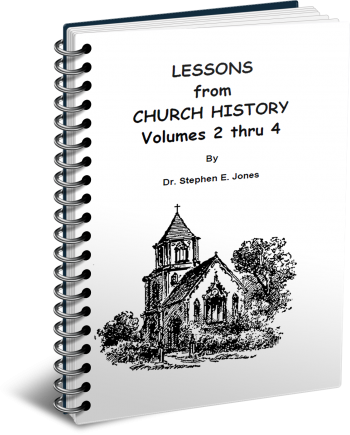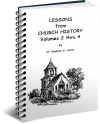Latest Posts
View the latest posts in an easy-to-read list format, with filtering options.

Volumes 2-4. This is the history of the Church from the Roman War (66-73 A.D.) to Constantine and the Council of Nicea in 325 A.D. with lessons to be learned from it.
Category - History and Prophecy

The last 40 years of the third century were relatively free of persecution for the Church. It was a time of unprecedented growth for Christianity, but it came at the expense of its character. Eusebius tells us in Eccl. Hist. VIII, i,
“How great, how unique were the honour, and liberty too, which before the [Diocletian] persecution of my time] were granted by all men . . . to the message given through Christ to the world . . . Witness the goodwill so often shown by potentates to our people; they even put into their hands the government of the provinces, releasing them from the agonizing question of sacrificing, in view of the friendliness with which they regarded their [Christian] teaching. What need I say about those in the imperial palaces and about the supreme rulers? Did they not permit the members of their households--consorts, children, and servants--to embrace boldly before their eyes the divine message and way of life, hardly minding even if they boasted of the liberty granted to the Faith? Did they not hold them in special esteem, and favour them more than their fellow servants? . . .
“How could one describe those mass meetings, the enormous gatherings in every city, and the remarkable congregations in places of worship? No longer satisfied with the old buildings, they raised from the foundations in all the cities churches spacious in plan. These things went forward with the times and expanded at a daily increasing rate . . .
“But increasing freedom transformed our character to arrogance and sloth; we began envying and abusing each other, cutting our own throats, as occasion offered, with weapons of sharp-edged words; rulers hurled themselves at rulers and laymen waged party fights against laymen, and unspeakable hypocrisy and dissimulation were carried to the limits of wickedness. At last, while the gatherings were still crowded, divine judgment, with its wonted [lack of] mercy, gently and gradually began to order things its own way, and with the Christians in the army the persecutions began.
“But alas! realizing nothing, we made not the slightest effort to render the Deity kindly and propitious; and as if we had been a lot of atheists, we imagined that our doings went unnoticed and unregarded, and went from wickedness to wickedness.”
This is how Eusebius explains the Diocletian persecution that broke out in February of 303 A.D., when he ordered churches to be destroyed, Bibles burned, and Christians forced on pain of death to sacrifice to the gods. These edicts were issued in Nicomedia, the capital of the Eastern half of the Empire.
When the first edict was posted, one of the Christians arrogantly tore it to shreds. Diocletian took this as an act of defiance, of course, and proceeded to persecute Christians out of anger and not merely out of love for the gods or of Roman law.
In spite of this shameful testimony, there were still many courageous believers among them who were able to face death willingly and even with rejoicing, as had their fellow martyrs in previous times. Eusebius tells us that he personally witnessed many of the martyrdoms in the city of Tyre as men were given to the wild beasts.
“When these things were going on, I was there myself and there I witnessed the ever-present divine power of Him to whom they testified, our Saviour Jesus Christ Himself, visibly manifesting itself to the martyrs. For some time the man-eaters did not dare to touch or even approach the bodies of God's beloved, but rushed at the others who apparently were irritating and provoking them from outside; only the holy champions, as they stood naked and in accordance with their instructions, waved their hands to attract the animals to themselves, were left quite unmolested. Sometimes when the beasts did start towards them, they were stopped short, as if by some divine power, and retreated to their starting-point. When this went on for a long time, it astounded the spectators, so that in view of the ineffectiveness of the first, a second and third beast were set on to one and the same martyr.
“You would see a youngster not yet twenty standing without fetters, spreading out his arms in the form of a cross, and with a mind unafraid and unshakeable, occupying himself in the most unhurried prayers to the Almighty; not budging in the least and not retreating an inch from the spot where he stood, though bears and panthers breathing fury and death almost touched his very flesh. Yet by some supernatural, mysterious power their mouths were stopped, and they ran back again to the rear. . .
“At last, when these animals had launched their terrible [but harmless] varied assaults, the martyrs were one and all butchered with the sword, and instead of being buried in the earth were given to the waves of the sea.” (Eccl. Hist., VIII, vii).
Eusebius again tells us (VIII, ix),
“I was in these places and saw many of the executions for myself. Some of the victims suffered death by beheading, others punishment by fire. So many were killed on a single day that the axe, blunted and worn out by the slaughter, was broken in pieces, while the exhausted executioners had to be periodically relieved. All the time I observed a most wonderful eagerness and a truly divine power and enthusiasm in those who had put their trust in the Christ of God. No sooner had the first batch been sentenced, than others from every side would jump on to the platform in front of the judge and proclaim themselves Christian.”
Eusebius lists a few of the Church leaders who died in this persecution: Anthimus, bishop of Nicomedia was beheaded; Lucian a presbyter in the same city; Tyrannion, bishop of Tyre; Zenobius, presbyter at Sidon; Silvanus, bishop of Emesa who was given to the wild beasts; Zenobius, “the best of physicians” died by hot plates applied to his sides; Silvanus, bishop of Gaza was beheaded with 39 others; two Egyptian bishops, Peleus and Nilus were burned at the stake. There are too many to mention, of course.
But two years into the persecution, Diocletian was struck down with mental illness, forcing him to retire in 305. He was replaced by Maximian, the other Caesar of the East who had ruled under him. But he was soon replaced by Licinius as Emperor of the East, by the common vote of the princes.
Shortly afterward, Constantius also died in the West and was replaced by his son, Constantine. The sheer number of caesars and emperors that had been created by Diocletian brought about a contest as the Empire was brought back gradually under a single head. In the end it was Constantine who won. First he overcame Maximian’s son, Maxentius, who had assumed power in the West (Rome), and in 324 he overcame Licinius in the East. Once he was firmly established as sole Emperor of Rome, he called for a Church Council at Nicea in 325 to settle the Aryan controversy in regard to the Trinity and whether Christ always existed or was created at some point in the past.
The persecutions were always limited in the areas where Constantine ruled, but when he took Rome at the Battle of the Milvian Bridge in 312, he was finally in a position to do more. In 311 he issued his famous Edict of Toleration, in which he allowed religious freedom for all. This was followed two years later in 313 by the Edict of Milan, signed by both of the co-emperors, Licinius and Constantine. These Edicts for the first time officially made Christianity a religio licita, a lawful religion.
Constantine has often been maligned as a pagan pretending to be a Christian, a sun-worshipper at heart, a politician who used Christians as a power base to gain power. These charges are inaccurate, as we can see by his earlier history. He protected the Christians long before it was politically expedient to do so.
Born and raised in Britain by a Christian mother, Helen, he was favorable to Christians from his early life. It is doubtful if he really knew what it was to be a genuine Christian. Christianity was usually presented as a religion that one joins. By that standard of measure, we should not be surprised if Constantine did things that we would not condone by our standards today.
Certainly, he was not responsible for church corruption, which already existed. He is to be credited with giving Christianity the freedom to worship which other religions enjoyed at the time, including Judaism. What the Church did with that freedom is another matter entirely. Constantine should not be made liable for any corruption in the Church.
Later, he asked the religious leaders to decide which doctrine was correct in the Arian controversy, and he used the force of law to back their decision. But once again, the Church leaders were responsible to know the Scriptures and to know the mind of Christ. Constantine was a new believer, schooled only in military and political matters. If he made mistakes, the bishops ought to have told him. But instead, the leaders delighted in appealing to the Emperor to enforce their excommunications against heresies, instead of permitting freedom of conscience.